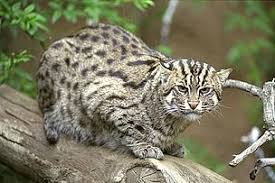Pakistan has long had difficulties with the gradual disappearance of its rare wild species due to a lethal mixture of environmental factors and induced by humans, in particular the destruction of habitat, the decrease in water resources, pollution and poaching.
Among these disappeared species, there is the endangered industrial cat, found mainly in the Indus delta and the surrounding buffer zones, where its number has dropped considerably in recent decades.
Loss of habitat, food rarity, hunting and growth of human populations have had a significant impact on this rare feline, which plays a vital role in maintaining the balance of aquatic ecosystems, according to experts.
“The last two decades seemed to be disastrous for this animal adapted to the environment, mainly due to the destruction of wetlands and murders of the local population,” anadolu Saed-Ul-Islam, an expert in Pakistani fauna.
Although official surveys have not yet determined specific figures, Islam has explained that conservative estimates suggest that the cat population in Pakistan has decreased by more than 50% in the last two decades.
Globally, the fishing cat population has decreased by around 30% since 2010, and the animal has been listed as vulnerable on the International Union for Nature Conservation (IUCN) Red List since 2016.
In addition to reducing water levels, deterioration in water quality has exacerbated the fate of these animals.
“The deterioration of water quality due to untreated water which flows directly into water bodies and the use of pesticides and chemical fertilizers, also weigh on conservation efforts,” noted Islam.
Last surviving predator in the region
Wildlife specialists consider the fishing cat the latest major predator surviving the floodplaces of the industrial after extinction close to others such as gharias, tigers and leopards from the region.
“We have this last predator in the floodplaces of the industrial which greatly contribute to maintaining the health animal populations in good health,” said Zafeer Ahmed Shaikh, Manager of the Industry Fishing Cat (IFCP) project.
IFCP, launched in 2021, is part of the Global Fishing Cat Conservation Alliance Initiative, which seeks to protect and preserve this rare species. The project initiates local communities, government authorities and wildlife organizations to support conservation efforts.
Before 2020, the status of the Indus fishing cat on the list of countries in Pakistan has remained uncertain, which suggests that the species was approaching extinction, according to Shaikh.
“It was we (IFCP) who told the world that this animal exists not only in Pakistan, but that its distribution range has extended to the river areas of the Sindh and the Balutchistan provinces through the channel network,” said Shaikh.
In addition to the Indus Delta, recent observations took place in the districts of Jaffarabad and Jhal Magsi in the province of southwest Balutchistan.
Challenges to determine the exact numbers
Shaikh has recognized the difficulty of determining the exact number of populations due to a lack of complete surveys by government agencies or wildlife groups.
“We cannot give a specific number on its population in Pakistan. But one thing is certain-its number has decreased due to the narrowing of wetlands and water bodies,” he said.
“This is why it is difficult to repair its current status, but it can be described safely as” almost in danger “, given the circumstances given”.
Shaikh acknowledged that, although IFCP made “a small difference” in the increase in figures for the fishing cat, “it’s a long way to go”.
Kamal Palari, a community worker involved in IFCP’s conservation efforts in the Sindh Th still, noted a significant reduction in hunting incidents involving fishing cat in recent years.
“Residents, especially farmers, would kill them because they wrongly believed that this cat was a threat to their cattle and their cultures,” Palari told Anadolu.
However, he said that the awareness campaigns launched by IFCP and that the increased participation in the community has led to a significant decrease in such cases.
Shaikh also said that the fishing cat “very rarely” attacks goats and does not have the capacity to considerably threaten the herds of breeding.
Balance aquatic ecosystems
Mumtaz Soomro, deputy director of the Sindh Wildlife Department, believes that strict wild animal protection laws promulgated in 2020 – imposing strong fines and sorrows to drive rare species – have also helped reduce the murders of fishing cats.
Soomro said that the department has worked with local communities and wildlife groups on awareness -raising campaigns to protect the cat, which, according to him, is “very important to keep marine life in good health”.
“We have already lost almost leopards, tigers and other predators due to factors induced by man. We cannot afford to lose this last predator,” he said.
In addition to reducing wetlands, Islam quoted overfishing by local communities as another critical reason for food shortages affecting the fishing cat.
He also underlined the vital role of the fishing cat in maintaining ecological balance in the Delta of the Indus.
“The fishing cat is a kind of low wetlands and can survive not only on fish but also on additional foods such as crabs, rodents and birds. The cat attracts only lazy animals and fish, helping to maintain the health of the remaining aquatic life,” said Islam.
Shaikh echoed these views, stressing the role of fishing cat in culture protection by controlling the populations of rodents and turtles.
“They control the population of small animals, so the ecosystem remains in balance,” he concluded.




